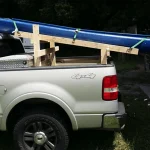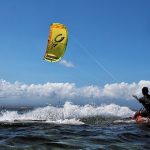When discussing the steadiness of a kayak, we are talking about its capability to remain upright and avoid overturning. What use is a kayak if it can’t keep you afloat?
Let’s dive into kayak stability…
What is kayak Stability?
So, what determines the stability of a kayak? Do you recall the physics class from your high school days that you thought would be of no use?
The stability of a kayak is determined by multiple aspects such as the ratio of its length to its width, the volume, and its center of gravity.
Center of gravity and center of buoyancy
The kayak must possess enough buoyancy to stay afloat, meaning that it has to weigh the same amount as the water that it is displacing. The mass of the object is determined by a line that descends from it, referred to as the center of gravity.
The mass of the water that has been displaced is measured by a vertical measure called the center of buoyancy. So long as the two are aligned, the kayak will remain steady and vertical.
When the kayak changes its position, its center of gravity shifts as well, so the center of buoyancy must adjust in order to keep the kayak steady and in an upright position.
This is known as a righting torque . If the center of gravity shifts too much, the center of buoyancy will go along with it and cause the boat to overturn.
The relationship between the center of buoyancy and the center of gravity dictates how steady the kayak is. As you surf, the focus of your weight is always fluctuating. If the point at which an object floats in water stays the same, you’ll end up having to get out of your boat while it’s still in the water.
Primary Stability
The initial steadiness of your kayak is how it behaves once you are sitting in it or on it.
How much does it resist tilting side to side? Will you tip over your kayak when you try to get in? This type of steadiness is referred to as primary stability and is often taken into account by those just beginning to use kayaks.
They are looking for reassurance that they won’t flip the kayak over when they attempt to enter it.
Secondary Stability
Secondary stability refers to the capability of a kayak to avoid overturning when leaned over (a maneuver referred to as “edging”). Kayaks which offer better secondary stability might seem “unsteady” when you first enter the vessel, but will then “catch” if you lean in one direction.
It is very difficult to locate a kayak that offers both ideal initial stability and secondary stability. You must select between the two options based on your purpose for purchasing a kayak and the kind of body of water you will be boating on.
Canoes with improved primary constancy are advantageous for paddling on serene bodies of water and sluggish-flowing streams. Kayaks designed for fishing have a great amount of initial stability, good for casting and even standing up.
Individuals who want to partake in whitewater kayaking, touring in the ocean, surfing rough waters, or competition should pay more attention to a kayak’s stability while in an unstable position.
What Determines a Kayak’s Stability?
What is the best way to determine the level of stability of a kayak and whether it has a greater amount of primary or secondary stability? Here are some factors you want to consider.
Type of Kayak
When it comes to picking a kayak, you have a range of different choices for a particular purpose. All of them have varying levels of stability, with either superior primary or secondary properties. Here are just a few:
Length to Width Ratio
This section is where things start to get technical. The stability of a kayak depends on its length, width, and volume.
To begin, let us look at displacement, which is the quantity of liquid that gets moved when a kayak is afloat in the water. The extra mass you put in the kayak increases the displace amount, which is calculated in terms of how much space it takes up.
Next up is length. There are two types of length. The first category is the size known as length overall (LOA), which is the measure of the kayak from the front to the back. The other measurement of length is where the edge of the kayak touches the waterline (LWL).
This kind of kayak is also referred to as its displacement length, which is more significant than its length overall, since it is the part that is submerged in the water.
The third factor to consider is how broad the kayak is at its broadest point. There are two distinct types of width – beam overall (BOA) and beam at the waterline (BWL), similar to length. The BWL is the section of the kayak which makes contact with the water, and is thought of as the width used to displace the liquid.
Are you still with me? Good.
Now we consider the length to width ratio, which we determine by this equation: length at waterline divided by the beam at the waterline, or more simply:
LWL/BWL
A kayak with a larger ratio between its length and width will be longer and consequently faster. As an example, whitewater kayaks will be 6 times as long as they are wide, whereas kayaks used for sprint racing should have a proportion of at least 11:1 or higher.
What is the significance of these numbers in regards to stability? Essentially, two kayaks could be the same size; however, the one that has a wider ranging ratio between length and width has a larger part of the vessel touching the water.
Therefore improving equilibrium. In comparison, a vessel of the same length with a greater amount of hulls will travel faster but be less steady as it will be making less contact with the ocean.
Hull Type
The hull is the bottom of your boat. There are two kinds of hulls: one is a planing hull and the other is a displacement hull. Despite this, many hulls have attributes of both kinds.
Planing Hull
The hull of the boat that is flattened on the bottom glides across the surface of the water. A kayak with a planing hull may be more secure with primary stability, however it takes a bit of time to achieve faster speed and they may flip very easily when encountering rough waves.
This type of hull is popular among whitewater kayaks.
Displacement Hull
The shape of a displacement hull is curved and it is created in such a way so as to part the water and cause it to be pushed aside as it progresses. Boats with this kind of hull are not very steady, but they are quicker to gain speed. They also have an easier time handling waves.
Hull Design
The shape of the hull should also be taken into account. The shapes of hull design can be classified into four categories: pontoon, v-shape, rounded and flat. Let’s take a look at each one.
V-Shaped Hull
The shape of this kayak is like a V, which is indicated by its name. It has a pointed base and rises steeply on one side. A kayak with a V-shaped bottom is designed to move swiftly through the liquid, giving the vessel more speed.
Due to its narrow connection to the water, novice kayakers will find this kayak to be unsteady and unstablized. Nevertheless, they possess extraordinary backup stability, and that “floppy” character disappears after you start.
Rounded Hull
A rounded hull is not as pointed as a V-shaped hull, yet it is still considered to be more efficient at steadiness when leaning than when upright. Kayaks with a curved outer shell are shaped like a torpedo and travel quickly.
Flat Hull
Flat-bottomed kayaks most likely provide the highest level of primary stability. Boats with flat bottoms have loads of contact with the water and don’t move at great speeds, making them a superb option for those not experienced with boating, fishers, and those who prefer laid-back paddling.
Pontoon Hull
The kayak that features a hull shaped like a flat-bottomed boat provides exceptional initial steadiness. Many fishing kayaks feature a pontoon-style design which permits the user to stand and throw out a line without having to fret about tipping over.
Pontoon-design kayaks will not go quickly, but some are so stable that you won’t be able to capsize them even in rough conditions.
Other Factors
We have discussed the shape of the hull, the proportion of length to width, and the type of kayak which impacts the primary and secondary stability of a kayak thus far. It is also essential to think about the width-to-length ratio of a kayak, the curved lines of its hull, the balance point, and the point at which the boat floats.
Best Overall Kayak for good stability
Wilderness Systems Pungo 120
Length: 12′-2″ |
Capacity: 325 lbs
REASONS TO BUY
- Great stability
- Good glide speed
- Comfortable
- Highly functional outfitting
- Easy to get it and out
REASONS TO AVOID
- Hard to drain
- Heavy
- Flimsy plastic hatch levers
The Wilderness Systems Pungo 120 has earned a reputation for excellence in every aspect. It is especially noteworthy for its steadiness, ability to move swiftly, and great ability to stay on course and drift smoothly.
The size of the cockpit was 20 inches which made it a really comfortable selection when compared to the other tested models due to the extra padding on the seat. The Pungo is a greatly adaptable and extremely cozy craft that is loved by the organization’s collection of boats due to its vast range of paddling possibilities.
Boats come in different shapes and sizes, offering the user the option of either selecting one that is more maneuverable or one with better tracking capabilities. Wilderness Systems has successfully put together a top-notch hybrid watercraft that can easily handle smooth rivers and achieve swift moves on still bodies of water.
It is evident why this boat had such a high score in our assessments when taking into consideration all of its exceptional qualities.
The kayak isn’t ideal; it is a bit lighter than typical, but the bulky structure makes it hard to maneuver alone. The hatch cover needs to be looked after periodically and differs slightly from the highly durable composition of the rest of the vessel. Although the cost of the Pungo is steep, its diverse functions make it well worth the cost.
This boat is capable of adapting to different types of paddling in different kinds of settings. It is worth your money if you’re looking for a single boat that can do it all.
Best Sit-on-Top Kayak with good stability
Wilderness Systems Tarpon 105
Length: 10′-6″|
Capacity: 325 lbs
REASONS TO BUY
- Easy to get in and out of
- Comfortable seat
- Versatile
- Ergonomically molded handles for transport
REASONS TO AVOID
- Heavy
- Slow
You can’t do certain activities in a sit-on-top kayak that you would be able to do in a sit-in kayak and the other way around. Sit-on-tops make it possible for you to enjoy a refreshing swim in the middle of the lake without fear of your boat filling with water or flipping over.
The Tarpon 105’s excellent features, storage, comfort and versatility made it an obvious choice when compared to the other sit-on-top kayaks we tested.
The Tarpon 105, created by Wilderness Systems, is a further development of the much-loved Tarpon sit-on-top series. This maneuverable kayak offers great storage, comfort, and functionality. T
he Tarpon’s excellent steadiness and uncomplicated design make it simple for riders to get on and off easily. Also, because it allows water to drain out, it doesn’t form any stagnant pools of water in the cockpit, which results in an enhanced level of comfort.
The Tarpon topped the other sit-on-top kayaks in our tests for its exceptional performance, making it a no-brainer selection.
Great Value for a Sit-On-Top Model with good stability
Ocean Kayak Malibu 11.5
Length: 11′-5″ |
Capacity: 360 lbs
REASONS TO BUY
- Extremely stable
- Great tracking
- Very durable
- Comfortable
- Stackable for storage
REASONS TO AVOID
- Heavy
- Slow to get up to speed
- Burdensome to load and carry
If you’re searching for a kayak that will offer the best value for your money and has many uses, the Ocean Kayak Malibu 11.5 is your best option. Ocean Kayak created a top-of-the-line product by taking the already successful Scrambler 11.5 kayak and adding comfort features like a seat cushion, adjustable backrest, and a splash-resistant dry hatch all at an affordable price.
The Malibu achieved greater success than other entries due to its sturdy construction, thoughtful design, and plentiful features and options.
The long keel and distinctive three-part hull structure of this vessel give it excellent directional stability and an effortless, quick motion, as well as impressive steadiness even in heavy winds and waves.
This boat has a lot of cargo capacity, making it perfectly suited for a long voyage or an overnight journey that requires a lot of supplies.




